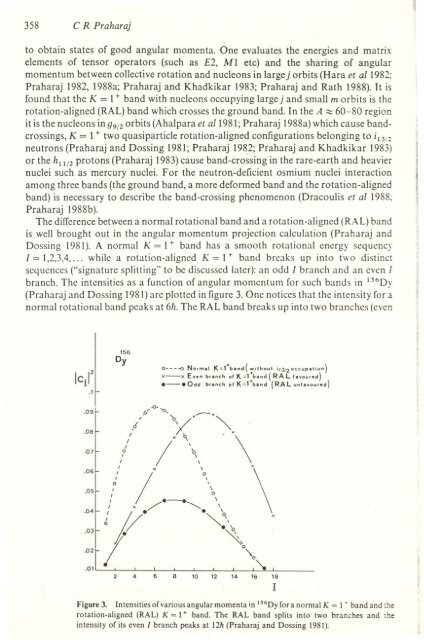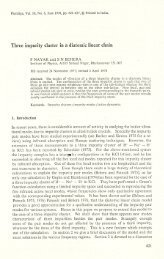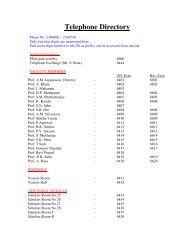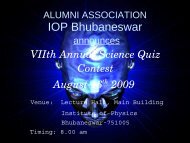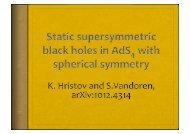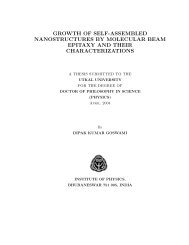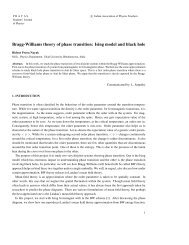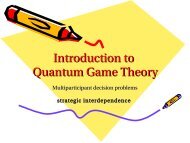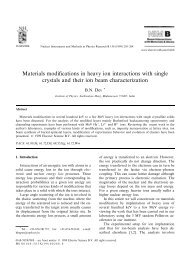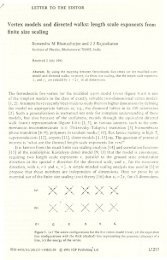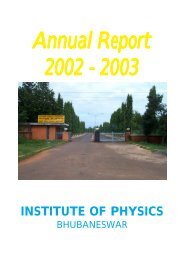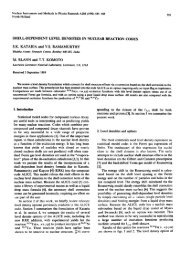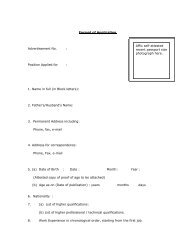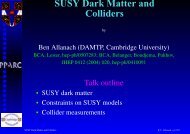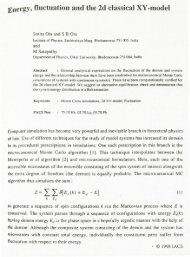Hartree-Fock theory of nuclear deformations and high spin states
Hartree-Fock theory of nuclear deformations and high spin states
Hartree-Fock theory of nuclear deformations and high spin states
Create successful ePaper yourself
Turn your PDF publications into a flip-book with our unique Google optimized e-Paper software.
358 C R Praharaj<br />
to obtain <strong>states</strong> <strong>of</strong> good angular momenta. One evaluates the energies <strong>and</strong> matrix<br />
elements <strong>of</strong> tensor operators (such as £2, Ml etc) <strong>and</strong> the sharing <strong>of</strong> angular<br />
momentumbetweencollectiverotation <strong>and</strong> nucleonsinlargej orbits (Hara et a11982;<br />
Praharaj 1982, 1988a; Praharaj <strong>and</strong> Khadkikar 1983; Praharaj <strong>and</strong> Rath 1988). It is<br />
found that the K = 1+ b<strong>and</strong> with nucleons occupying largej <strong>and</strong> small m orbits is the<br />
rotation-aligned (RAL) b<strong>and</strong> which crosses the ground b<strong>and</strong>. In the A ~ 60-80 region<br />
it is the nucleons in g9/2orbits (Ahalpara et a11981;Praharaj 1988a)which cause b<strong>and</strong>crossings,K<br />
= 1+ two quasiparticle rotation-aligned configurations belonging to ;13/2<br />
neutrons (Praharaj <strong>and</strong> Dossing 1981; Praharaj 1982; Praharaj <strong>and</strong> Khadkikar 1983)<br />
or the h11/2protons (Praharaj 1983)cause b<strong>and</strong>-crossing in the rare-earth <strong>and</strong> heavier<br />
nuclei such as mercury nuclei. For the neutron-deficient osmium nuclei interaction<br />
among three b<strong>and</strong>s (the ground b<strong>and</strong>, a more deformed b<strong>and</strong> <strong>and</strong> the rotation-aligned<br />
b<strong>and</strong>) is necessaryto describethe b<strong>and</strong>-crossingphenomenon (Dracoulis et al 1988;<br />
Praharaj 1988b).<br />
The difference between a normal rotational b<strong>and</strong> <strong>and</strong> a rotation-aligned (RAL) b<strong>and</strong><br />
is well brought out in the angular momentum projection calculation (Praharaj <strong>and</strong><br />
Dossing 1981). A normal K = I + b<strong>and</strong> has a smooth rotational energy sequency<br />
1= 1,2,3,4,... while a rolation-aligned K = I + b<strong>and</strong> breaks up into two distinct<br />
sequences ("signature splitting" to be discussed later): an odd I branch <strong>and</strong> an even I<br />
branch. The intensities as a function <strong>of</strong> angular momentum for such b<strong>and</strong>s in 1SODy<br />
(Praharaj <strong>and</strong> Dossing 1981)are plotted in figure 3. One notices that the intensity for a<br />
normal rotational b<strong>and</strong> peaks at 6". The RAL b<strong>and</strong> breaks up into two branches (even<br />
2<br />
IcII<br />
.1<br />
.09<br />
.08<br />
.07<br />
156<br />
Dy<br />
o---~ No,mol K:I+bond( w;lhoul ;f3/2OCCuPol;on)<br />
x-x E YOn bunch <strong>of</strong> K :1 +bond ( RA L f owound)<br />
.-.Odd b,onch <strong>of</strong>K:I+bond (RALunhwound)<br />
.0-<br />
,f'J' '0,<br />
d \ /x_x<br />
, /. "-<br />
/ '., '\,<br />
.,,"./ / 0\<br />
\ '- .<br />
Ix<br />
\<br />
"<br />
.05f- ~ °, x<br />
..f-! . \<br />
.'<br />
)//. '"<br />
.03f- CO / " \<br />
.02f- ~,<br />
°<br />
. 01' CO~<br />
. ' ' .<br />
2 4 6 8 10 12 14 16 18<br />
I<br />
Figure 3. Intensities <strong>of</strong> various angular momenta in 156Dy for a normal K = 1- b<strong>and</strong> <strong>and</strong> the<br />
rotation-aligned (RAL) K = 1 + b<strong>and</strong>. The RAL b<strong>and</strong> splits into two branches <strong>and</strong> the<br />
intensity <strong>of</strong> its even I branch peaks at 12h (Praharaj <strong>and</strong> Dossing 1981).


